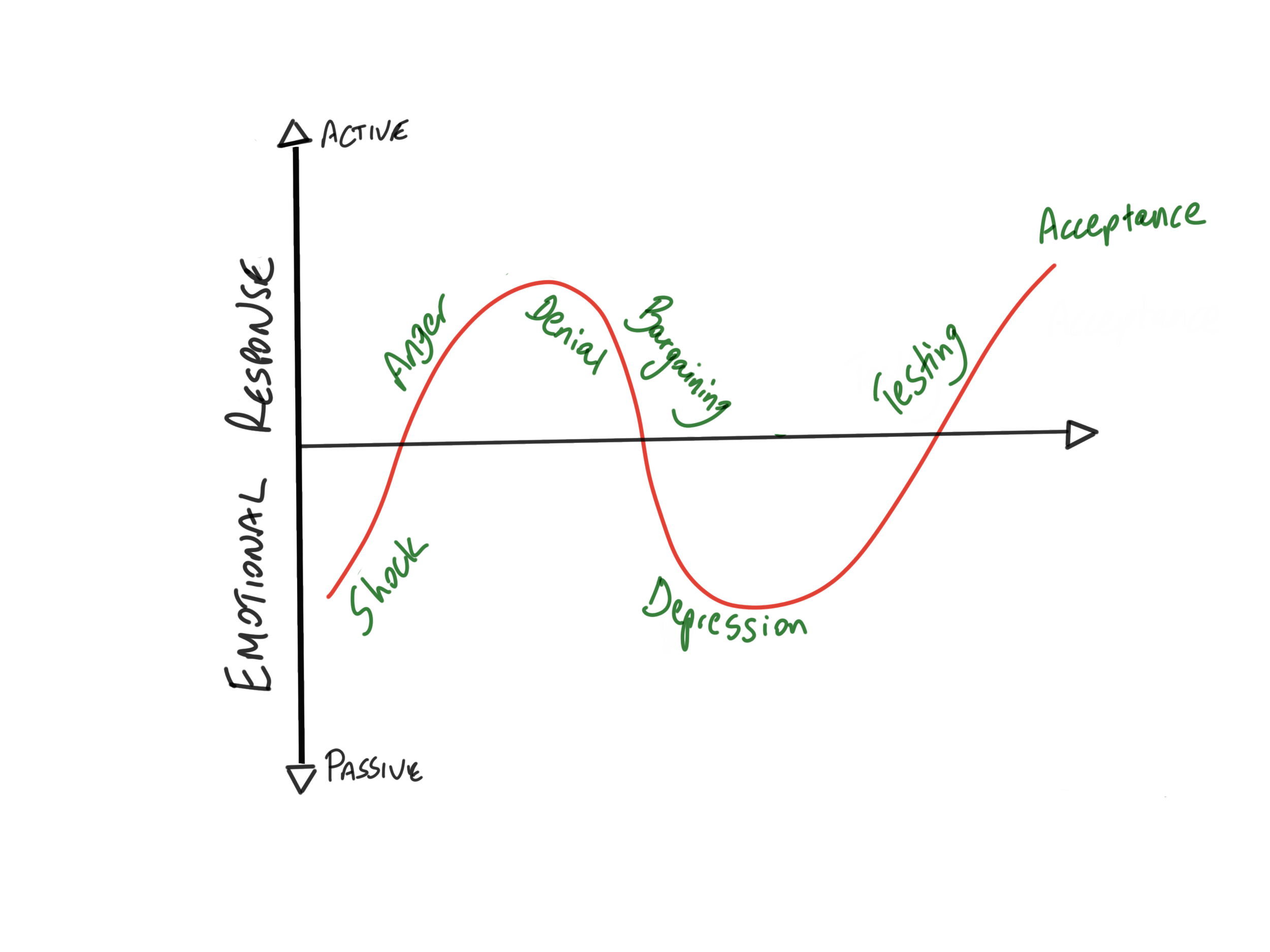Is AI the Bogeyman of Copywriting?
When new technologies impact our world, should we embrace them or fear them?
Here we take a fresh perspective on AI and what it may mean for Copywriting and writing-related industries.
Take shelter! Hide!
AI is here, and it’s going to take our jobs!!!
It’s “AI-geddon” 😱 and we’re all DOOOOOMED!
Little Timmy and Suzie won’t have dinner to eat and will have to work the coal mines to support their parents (those “old fashioned” laggard writers!)
Of course, we’re poking fun at the idea that AI is going to take everyone’s jobs and make Copywriters redundant, forcing us back into an agrarian society.
With every iteration of technological change, there have always been increased opportunities for those willing and able to adapt.
On the flip side, some industries fall by the wayside if their business model is heavily entrenched in processes that can’t (or won’t) incorporate into the new ways of working.
Let’s look at some basic theories around change and psychology
We humans are funny creatures, aren’t we? Creatures of habit.
We like to do things a certain way, go to the same café every day, drive along routes we’re familiar with, and mingle with people like us.
This familiarity is comfortable, right? Wonder why it feels so comfortable?
Because it's predictable, and safe.
Flipping these around, unpredictability isn’t safe as it’s unknown and untested.
The need to feel safe is inherent in our DNA; we’re hard-wired to avoid change, since change could mean danger, with the worst-case scenario being death.
“Hang on, aren’t we talking about AI and copywriting? How did we get all doom and gloom?”
Sure, it may seem far-fetched, but then again, the parallels may not be so dissimilar.
Here’s why:
As smart and sophisticated as we are, with our technological advances and creature comforts, our DNA still operates from a prehistoric perspective. Let’s face it, we’re cave people with laptops, salivating over a strong 5G Wi-Fi connection.
And one small section of the brain tucked away in our limbic system is what psychologists refer to as the “reptilian part of our brain”.
Behold the small almond-shaped gland called the amygdala!
The amygdala triggers the classic “fight, flight, fawn or freeze” response that served us well back in the day to avoid oncoming sabre-toothed tigers. But it’s mostly irrelevant in our modern lives.
Of course, if we were cornered in a dark alleyway by a group of hoodie-wearing, cherry flavoured vape smoking teenagers, our amygdala would trigger the “reptilian” part of our nervous system and fire off alerts to get out of there ASAP.
But pending a gang of vaping teenagers cornering us in the middle of the night, our amygdala generally can’t distinguish differences between real threats and imagined ones.
A case in point is the queasy feeling and foreboding dread we may feel before giving a presentation to a room full of “important” people. It’s unlikely you’d be attacked for your presentation (no matter how terrible it may be) but your limbic system and amygdala are firing off all kinds of trigger warnings to your body, hence the sweating, sick in the stomach feeling and overall dread.
And the crazy thing is, we can’t control it, no matter how smart and sophisticated we are!
Accepting this very quick explanation of our un-evolved brain and limbic system, what does this mean from a change perspective?
Change management practitioners and psychologists refer to the cycle of change, describing the emotions people commonly go through when dealing with a significant change in their lives (marriage/divorce, birth/death, redundancy etc).
Here is a visual representation of the change cycle, and some of the emotions people may feel over time:
Given we’re talking about AI and the impact of change, some of the following comments may be typical of someone going through the stages of change:
What’s important to note is these stages are not linear – people can go back and forth between stages.
Also, the resistance to change is often proportional to how much someone has invested in the previous ways, status they had, and what the change means to them in their current age and stage in life.
The greater the investment in the old ways of doing things, the more likely they’ll be stuck in this cycle.
Technological impacts and the idea of redundancy
Let’s face it, technology is forever changing at lightning speed.
Whether that’s something you’re comfortable with or terrified of, there’s no denying it’s often a case of “get on board or get left behind”.
The idea of having a skillset made redundant after working so hard to become an expert would be terrifying!
Especially if your livelihood depends on it (cue the cries from little Timmy and Suzie we met earlier and the cold, dark conditions of that coal mine… 😢).
That’s when the most resistance comes, with people circling between stages of anger and denial we saw earlier in the change cycle.
Those who have the courage to accept the reality of the situation are the ones who move forward.
Whether we like change or not, it’s always a constant.
What AI may do for some creative writers in the industry
While we don’t have the benefit of hindsight yet, we can make some assumptions about the impacts AI could have in this space.
Mind you, these won’t happen overnight, but the way I see playing out would be:
1. Weeding out the lazy writers
Writers who think they can pop in a few prompts into an AI writing tool and produce content and copy that informs or sells can think again.
While the result may be grammatically correct and adhere to a specified word count, doesn’t mean it hits the mark as quality output.
Pretty soon people will become familiar with bot-produced content and learn to ignore it, much like lazy or uninspired content produced today.
Moreso, the AI tool will not have a unique point of view, and without that, it will fail to make an impact.
It may be a great starting point if you’re low on time or inspiration, but as the saying goes “the secret to writing is re-writing”.
Come on, don’t be lazy…you’re better than that!
2. Adjustment Period (disclaimer: the tarot reader looked drunk during the reading, so this may or may not happen…)
This is when most businesses and writers accept that AI is not going anywhere, and it becomes the norm.
Some of the fallouts could include:
Brand and Tone of Voice becoming diluted, inconsistent, conflicting, or inappropriate
Social and Cultural context is lacking, so AI-generated text may lack nuance and humour
The risk of errors or liability may increase. Technical or highly specialised writing may contain inaccuracies or ambiguity, that could lead to reputational damage or litigation
There are fewer new writers entering the industry as the work becomes cannibalised by AI tools, or rates become so low that veteran writers exit the industry in droves.
3. Copywriters and Content writers becoming expert editors and “prompt” writers
By this point, being a copy or content writer is about as enticing as buying a new car with wind-down windows…
Does this mean that copy and content writing is dead?
Yes and No.
Like anything shaped by changing technology, it’s likely to morph into something different.
Enter the Expert Prompt Writing Editors (yes, I have coined a new term for a new sub-genre of future jobs).
These people are the ones who have been in the industry long enough to really understand branding, TOV and client needs, and have adapted to new ways of working.
They are overseers rather than content producers.
It’s kind of like being promoted to a managerial position of a department because you have a lot of experience, overseeing the work output of others. You do less of the “hands-on” stuff, instead providing advisory, encouragement or corrections to your team’s output (but in this case, the “team” are AI bots…🤖)
Perhaps the future successful writers are those who are expert marketers and know the best prompts for AI to produce helpful and accurate copy faster than their competitors.
But one technological beast is fighting back
Enter the MEGA BEAST (a.k.a Google).
In its Helpful Content update in August 2022, Google had this to say about changes to its algorithms relating to authoring and credibility:
“Would you expect to see this content in or referenced by a printed magazine, encyclopedia, or book?
Does the content present information in a way that makes you want to trust it, such as clear sourcing, evidence of the expertise involved, background about the author or the site that publishes it, such as through links to an author page or a site’s About page?
Is this content written by an expert or enthusiast who demonstrably knows the topic well?”
Ok, so Google is clear about what type of content it favours.
Google wants its users to find content that’s written by a credible expert, someone who is known, is not anonymous and can be linked back to the information source.
Google wants its users to know who created and authored the content.
So did Google have anything to say about AI in the context of its Helpful Content update?
Yes, yes it did.
Specifically, Google mentions this about AI produced content:
“If automation is used to substantially generate content, here are some questions to ask yourself:
Is the use of automation, including AI-generation, self-evident to visitors through disclosures or in other ways?
Are you providing background about how automation or AI-generation was used to create content?
Are you explaining why automation or AI was seen as useful to produce content?
Overall, AI or automation disclosures are useful for content where someone might think “How was this created?”
”
If Google continues to hold the monopoly on Search Engine capability as the first point of call for information searches, it looks as if AI-generated content is…
…how shall we put it…
…frowned upon.
So where do we go, now, where do we go?
We’ve seen how technology moves with fever-pitched intensity, resulting in change and uncertainty.
Where will it all lead to?
Who can say for sure?
One thing that’s clear is open-minded people tend to adopt change a lot easier, which is usually a good thing.
So here are some of my quick tips for using AI as a tool to serve you, not replace you:
Help overcome writer’s block
Avoid procrastination by using an AI tool to make a start (while you make yourself a cup of tea)
Spark some inspiration and get out of a writing rut
Do keyword and other research
If you’re super busy or under unrealistic deadlines, use it to produce a first draft and edit, edit edit!
Or just ignore it – there’s that option too!
But if it helps you save time or quickly generate ideas when stuck – go for it. As long as you edit, refine and always have a point of view, it’s ok.
Now take a Bex and have a lie-down…
John is the Head Writer and Strategist at Verb & Noun.
He lives in bayside Melbourne and loves bagels



